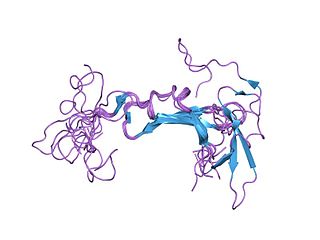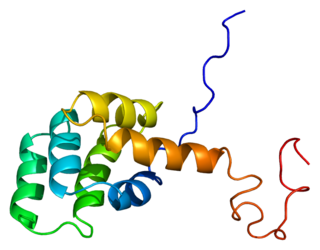Neuregulin 2, also known as NRG2, is a protein which in humans is encoded by the NRG2 gene. [5] [6] [7]
Neuregulin 2, also known as NRG2, is a protein which in humans is encoded by the NRG2 gene. [5] [6] [7]
Neuregulin 2 (NRG2) is a novel member of the neuregulin family of growth and differentiation factors. Through interaction with the ErbB family of receptors, NRG2 induces the growth and differentiation of epithelial, neuronal, glial, and other types of cells. The gene consists of 12 exons and the genomic structure is similar to that of neuregulin 1 (NRG1), another member of the neuregulin family of ligands. NRG1 and NRG2 mediate distinct biological processes by acting at different sites in tissues and eliciting different biological responses in cells. The gene is located close to the region for demyelinating Charcot-Marie-Tooth disease locus, but is not responsible for this disease. Alternative transcripts encoding distinct isoforms have been described. [5]

Neuregulins or neuroregulins are a family of four structurally related proteins that are part of the EGF family of proteins. These proteins have been shown to have diverse functions in the development of the nervous system and play multiple essential roles in vertebrate embryogenesis including: cardiac development, Schwann cell and oligodendrocyte differentiation, some aspects of neuronal development, as well as the formation of neuromuscular synapses.

Receptor tyrosine-protein kinase erbB-2, also known as CD340, proto-oncogene Neu, Erbb2 (rodent), or ERBB2 (human), is a protein that in humans is encoded by the ERBB2 gene. ERBB is abbreviated from erythroblastic oncogene B, a gene isolated from avian genome. It is also frequently called HER2 or HER2/neu.

The Fas receptor, also known as Fas, FasR, apoptosis antigen 1, cluster of differentiation 95 (CD95) or tumor necrosis factor receptor superfamily member 6 (TNFRSF6), is a protein that in humans is encoded by the FAS gene. Fas was first identified using a monoclonal antibody generated by immunizing mice with the FS-7 cell line. Thus, the name Fas is derived from FS-7-associated surface antigen.

Neuregulin 1, or NRG1, is a gene of the epidermal growth factor family that in humans is encoded by the NRG1 gene. NRG1 is one of four proteins in the neuregulin family that act on the EGFR family of receptors. Neuregulin 1 is produced in numerous isoforms by alternative splicing, which allows it to perform a wide variety of functions. It is essential for the normal development of the nervous system and the heart.

Receptor tyrosine-protein kinase erbB-3, also known as HER3, is a membrane bound protein that in humans is encoded by the ERBB3 gene.

Receptor tyrosine-protein kinase erbB-4 is an enzyme that in humans is encoded by the ERBB4 gene. Alternatively spliced variants that encode different protein isoforms have been described; however, not all variants have been fully characterized.

5-hydroxytryptamine receptor 3A is a protein that in humans is encoded by the HTR3A gene.

GDNF family receptor alpha-1 (GFRα1), also known as the GDNF receptor, is a protein that in humans is encoded by the GFRA1 gene.

Fms-related tyrosine kinase 3 ligand (FLT3LG) is a protein which in humans is encoded by the FLT3LG gene.

Macrophage scavenger receptor 1, also known as MSR1, is a protein which in humans is encoded by the MSR1 gene. MSR1 has also been designated CD204.

Decoy receptor 3 (Dcr3), also known as tumor necrosis factor receptor superfamily member 6B (TNFRSF6B), TR6 and M68, is a soluble protein of the tumor necrosis factor receptor superfamily which inhibits Fas ligand-induced apoptosis.

Ephrin type-B receptor 6 is a protein that in humans is encoded by the EPHB6 gene.

Ephrin A4 is a protein that in humans is encoded by the EFNA4 gene.

Ephrin A3 is a protein that in humans is encoded by the EFNA3 gene.

P2X purinoceptor 5 is a protein that in humans is encoded by the P2RX5 gene.

E3 ubiquitin-protein ligase NRDP1 is an enzyme that in humans is encoded by the RNF41 gene.

P2X purinoceptor 2 is a protein that in humans is encoded by the P2RX2 gene.

Gamma-aminobutyric acid (GABA) A receptor, alpha 5, also known as GABRA5, is a protein which in humans is encoded by the GABRA5 gene.

Neuregulin 3, also known as NRG3, is a neural-enriched member of the neuregulin protein family which in humans is encoded by the NRG3 gene. The NRGs are a group of signaling proteins part of the superfamily of epidermal growth factor, EGF like polypeptide growth factor. These groups of proteins possess an 'EGF-like domain' that consists of six cysteine residues and three disulfide bridges predicted by the consensus sequence of the cysteine residues.

Neuregulin 4 also known as NRG4 is a member of the neuregulin protein family which in humans is encoded by the NRG4 gene.